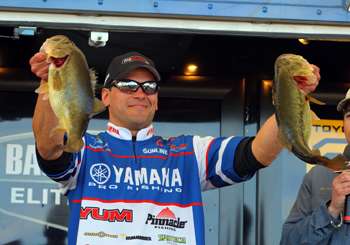
A depth change of 2 feet or 20 feet could be a good wintertime bass hideout, according to Dave Wolak. “The best locations on reservoirs that I’ve found are holes,” says Wolak. “Fish really group up in holes in the winter if you have a lake where the average depth is less than what is adequate for the fish to stay in a stable environment.”
An example of a wintering hole Wolak targets is a ditch 20 to 30 feet deep in the middle of a long creek arm featuring an expansive flat. The water is too cold at the average depth of the flat (about 10 feet deep), so the bass seek out the deepest water they can find for a comfort zone. “If you find key vertical cover on parts of that ditch or where there’s a lot of forage ganged up, you can really find the bass stacked up,” says Wolak.
On a natural, shallow lake in Florida, the best winter hideout could be a hole 6 feet deep at the edge of hydrilla. Wolak notes there might be only a 2-foot drop from the edge of the vegetation into the hole, but the bass seek refuge there because it’s the deepest water in the area. Wolak’s favorite wintertime spots vary depending on the body of water.
On shallow, lowland reservoirs, he looks for cover such as old house foundations, stump rows and brushpiles close to ditches or creek channels. “In highland reservoirs, I try to get up in the rivers to fish the bends and turns that have a lot cleaner rock and more vertical drops,” he says.
The North Carolina pro suggests the best winter spots are similar to good summertime haunts. “You have to have a place where all those fish are coming from, such as a spawning flat or where grass grows all year long or stump rows that pour into a channel,” he says.
“Points are always good in the winter because they’re a magnet for fish that are pulling from somewhere shallow to deeper water.” He also notes that points are ideal spots for fish wintering in deep holes to move up quickly on warm days.
Rocks are always a key for Wolak when searching for winter hotspots. “Rock mixed in with all of the other variables just makes a spot better,” Wolak says. The 2011 Bassmaster Classic qualifier searches for winter bass hideouts with his Humminbird 998 side-imaging unit. “I use side scan and down imaging to find the key place in an area,” says Wolak. “With side imaging I get a better feel of where those fish are and why they’re holding in one spot.
For instance, when an old creek channel makes a hard bend and there’s a big stump row on an outside turn, that’s usually a deeper hole than the rest of the creek channel. Spots like that have been the best deals for me.” Weather conditions can determine which wintertime spots will produce best for Wolak. Lots of sun shining on a winter hideout can be a bonus.
“I don’t weigh that as heavily as I do the other things, such as where the fish are coming from, the rocks, the vertical aspect of the spot or the forage,” says Wolak. “Good spots do become better with sun exposure, but it’s not a factor in making a nothing spot into a good spot.” Wind plays more of a role in determining which winter hideouts Wolak targets each day.
On sunny days, Wolak keys on spots receiving the most wind because it causes the warmer surface water to mix with the cooler lower layers of water to warm up the spot a few degrees. He prefers fishing these spots with crankbaits, jerkbaits and spinnerbaits that can be fished at mid-depth levels.
During cloudy days, Wolak keys on the deepest winter hangouts where the fish hug the bottom. His favorite lures for probing these depths are jigs and lipless crankbaits.
Editor’s Note: If you have a story idea you would like to vote on for an upcoming poll, send your idea to john@jnoutdoors.com.





